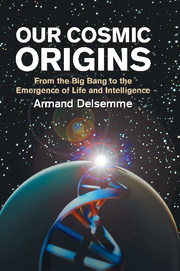Book contents
- Frontmatter
- Contents
- Foreword
- Preface
- Acknowledgments
- 1 Locating humans in the Universe
- 2 The race toward complexity
- 3 The stellar alchemy of metals
- 4 The formation of the planets
- 5 The emergence of life
- 6 The history of life
- 7 The awakening of intelligence
- 8 The other worlds
- 9 Perspectives
- APPENDIX A The standard model of the physics of elementary particles
- APPENDIX B Symmetry in physics
- APPENDIX C The strange role of time in relativity
- APPENDIX D The measurement of long time spans and the age of the Universe
- APPENDIX E The standard model of the Big Bang
- APPENDIX F The cause of the Big Bang and inflation
- APPENDIX G Chirality
- Glossary
- Bibliography
- Figure index
- Table index
- Name index
- Subject index
APPENDIX E - The standard model of the Big Bang
Published online by Cambridge University Press: 05 August 2012
- Frontmatter
- Contents
- Foreword
- Preface
- Acknowledgments
- 1 Locating humans in the Universe
- 2 The race toward complexity
- 3 The stellar alchemy of metals
- 4 The formation of the planets
- 5 The emergence of life
- 6 The history of life
- 7 The awakening of intelligence
- 8 The other worlds
- 9 Perspectives
- APPENDIX A The standard model of the physics of elementary particles
- APPENDIX B Symmetry in physics
- APPENDIX C The strange role of time in relativity
- APPENDIX D The measurement of long time spans and the age of the Universe
- APPENDIX E The standard model of the Big Bang
- APPENDIX F The cause of the Big Bang and inflation
- APPENDIX G Chirality
- Glossary
- Bibliography
- Figure index
- Table index
- Name index
- Subject index
Summary
The standard model does not try to explain the cause of the Big Bang. It starts from the present conditions of average density and temperature in the Universe. If we go backwards in time, the Universe was smaller; its density and temperature can be computed for some typical epochs in the past.
(1) Average density. The present Universe is very unhomogeneous, so that its average density can be estimated only by using a very large volume, for instance, a cube of 500 million light-years on each side, for which the total mass of millions of galaxies can be assessed. The average density found by this method is a little less than 10-30 g/cm3.
(2) Average temperature. There are now still 3 billion photons at 2.7 K in the fossil radiation coming directly from the Big Bang, for each hotter photon arriving from the stars. These stellar photons are therefore the insignificant and negligible traces left by the fireworks from the primordial explosion. The average temperature of the Universe is 2.7 K.
(3) Expansion velocity. Its rate is given by the Hubble constant, H, which can be taken, for instance, as H = 25 km/second per million light-years.
In Table E.1, results have been rounded to the nearest factor of 10. The Universe cooled, as for example in an explosion gases cool as they fill a larger and larger volume, so that it is easy to compute the temperature and density at different times in the past.
- Type
- Chapter
- Information
- Our Cosmic OriginsFrom the Big Bang to the Emergence of Life and Intelligence, pp. 289 - 292Publisher: Cambridge University PressPrint publication year: 1998

